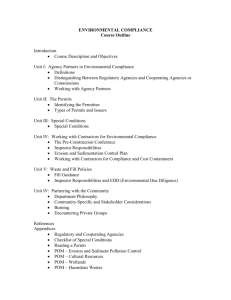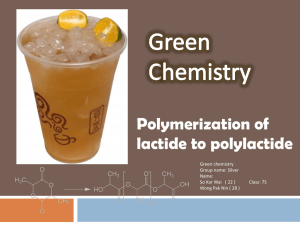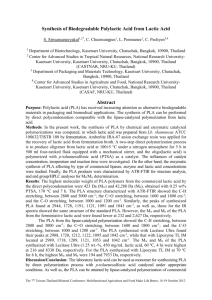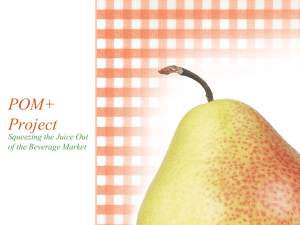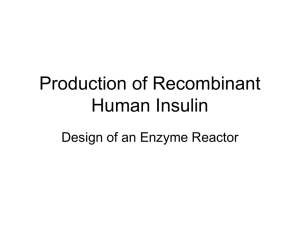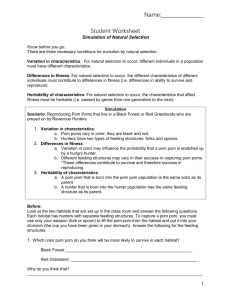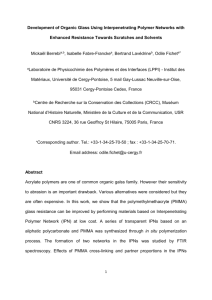2013 - The Cooper Union
advertisement
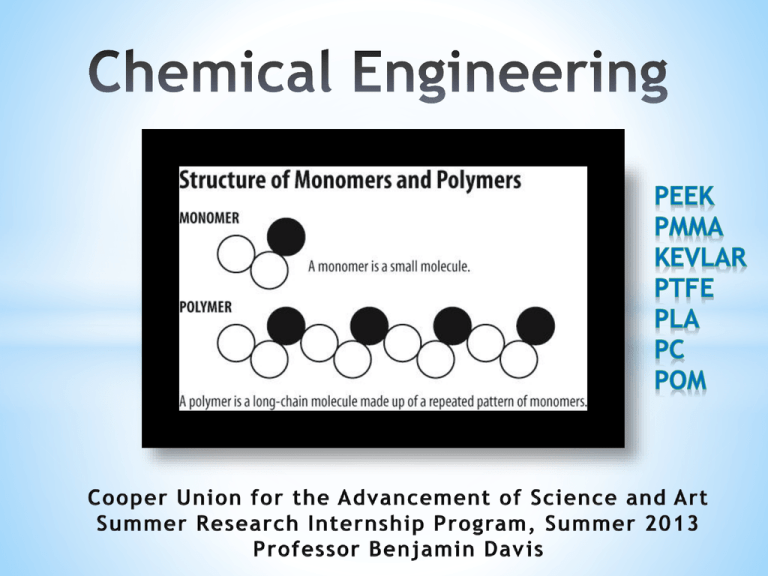
Rabia Akhtar and Ozzy Khan The percentage share of world consumption of Victrex PEEK by sector for the year 2012. Industrial: 39% Electronics: 24% Transport: 26% Medical: 11% PEEK DFBP Hydroquinone Sodium nitrate DADM Arbutin Formaldehyde Aniline Methanol Nitrobenzene CO2 Benzene Petroleum Nitric acid Nitrogen Dioxide H2O H2 Hydrogen fluoride Tank Size: 3,400 L Temperature: 90ºC Time: 41.7 days/batch Batch size: 3750 kg Spools per batch: 4,650 Spools per day: 100 Spool size: 250’ 1” PEEK electrical sleeving Polymethyl Methacrylate: PMMA Saijah Williams Mia Rodie History and Markets • Discovered in 1877 by Fittig and Paul Uses and Properties (pontiacgrandprix.net) 1972 Olympic Stadium- Munich, Germany Headlights made of PMMA Edge-lighting.com Lighting Applications of PMMA LG LCD television Polymer Chemistry • PMMA is made of methyl methacrylate. PMMA is most commonly polymerized through free radical polymerization. • The application of PMMA traces back to the type of polymerization used. Type of Polymerization Application Bulk Plexiglas® Solution Adhesives, paint resins Suspension PMMA beads Emulsion Paper coating agents, paper processing agents, textile binders Raw Materials and Production Process Methyl formate Acetone Methyl formate Acetone Hydration of acetonecyanhydrin Prussic acid ahydroxyisobutyric acid amide Hydrogen Cyanide methyl ahydroxyisobutyric Methyl methacrylate Reactor Design • Goal: 100 sheets of Plexiglas® per day • Amount of PMMA per year: 800 metric tons • Amount of time per batch: 5.6 minutes Equation 1 Variable Meaning Ki, Kp, Kt Rate constants p Polydispersity [M] Concentration of monomer [I] Concentration of initiator By: Caroline Hunt & Isael Luperon History and Market Created in 1964 by Stephanie Kwolek Produced by DuPont First commercial use in 1971 Mainly produced in USA Costs : $12 - $27 Uses & Properties Advantages: Tensile strength Chemical resistance Structural rigidity Thermal resistance Lightweight Disadvantages: Absorbs moisture Poor against compression Poor against UV rays 6 2 3 4 7 5 Polymer Chemistry 1,4-phenylene-diamine (para-phenylenediamine) Terephthaloyl Chloride Hydrochloric Acid (byproduct) Poly-para-phenylene Terephtalamide (Kevlar) Results of Reactor Design Goal: 1,000 pairs of Kevlar gloves per day Total monomer: 835 moles Total solvent: 278 moles Total volume of tank: 150 Liters Time for one reaction: 9.7 seconds Properties, Uses, and Production of Polytetrafluoroethylene By Sally Kramer Dr. Roy Plunkett History, Discovery, Markets, Demand, Chemical Formula and Prices Teflon Roy Plunkett 1938 DuPont Company Production rate of 900 tons per year in 1948 will grow to 240,000 tons per year by 2017 PTFE Price as a Function of Time 10 9 Figure 2 Price per pound ($) 8 7 6 5 4 3 2 1 0 2010 Year 2011 Uses and Properties Polymer Chemistry, Raw Materials, and Production Process CHCl3 + 2HF CHClF2 + 2HCl 2CHClF2 F2C=CF2 + 2HCl Fluorspar, water, sulfur, air, natural gas (1) (2) Ethics and Safety Carcinogens and birth defects “Fracking” for natural gas Don’t leave an empty Teflon coated pot or pan over an open flame! If your pan starts to look like this, throw it away! Reactor Design for Gaskets Goal: 10,000 Teflon gaskets per day, each 12.947g Ten hours per batch, two batches per day 24.399 kg dimethylamine oxide dihydrate 87.14 kg TFE 8.714 kg glacial acetic acid 26,142 kg water 64.725 kg PTFE Producing Polylactic Acid By: Kevin Garcia and Janki Tailor History/ Discovery/ Introduction O Similar to petroleum based plastics but its biodegradable O Lactic acid discovered in 1780 by Carl Wilhelm Scheele and PLA discovered in 1932 by Wallace Carothers. O First official PLA production plant launched in Blaire, Nebraska. Markets/ Demand/ Prices O Used in fibers, packaging, and chemical products markets O Archer Daniels Midland Company, Cargill Inc., and Ecochem O 6.6 billion lbs. PLA produced annually$6 billion per year O Global lactic acid production: 40,000 tons per year Markets and Markets. http://www.marketsandmarkets.com/MarketReports/polylacticacid-387.html (accessed July 9th, 2013), Global Lactic Acid & Polylactic Acid (PLA) Market by Raw Materials, Types, Applications, and Potential Opportunities (Forecast to 2016). Uses/ Properties Rigids Food Serviceware The Potential of Bio-Based Plastics. Steeman, A. http://bestinpackaging.com/2009/11/30/the-potential-ofbio-based-plastics/ (accessed August 7, 2013). Excellent Packaging & Supply (EPS). http://www.packagingint.com/suppliers/excellent-packaging-supply-eps.html (accessed August 7, 2013). Polymer Chemistry O Monomer: L-Lactide (two lactic acids combined) O Most methods for making PLA are not economically viable O Methods to synthesis PLA: O Step Growth O Ring Open Polymerization L-Lactide Futerro. http://www.futerro.com/products_lactide.html (accessed August 7, 2013). Lactic Acid Intech. Jamshidian et al. http://www.intechopen.com/books/biodegr adation-life-of-science/biodegradablepolymers (accessed July 23, 2013). Raw Materials/ Production/ Safety Corn Starch Fermentation Step Growth PLA Lactic Acid Ring-open Polymerization Lactide O PLA is eco-friendly, and releases carbon dioxide and methane when it degrades Batch Design O Task: To design a batch reactor to make these cups O Goal: Make 10,000 plastic cups/day O Bulk Reaction O Catalyst used for reaction: Tin Octoate Fabri-Kal. http://www.fabri-kal.com/product/greenware-colddrink-cups/ (accessed August 6, 2013) Results for our Batch Reactor OTime per batch: 200 hours Lactide OBatches per year: 44 batches OCups produced per batch: 82,955 cups OMass of monomer used per cup: 48.65 g OVolume of batch reactor: 3.16 cubic meters PLA Paulina Babiak And Fradah Gold Uses and Properties Polymer Chemistry and Safety Phenyl Groups Methyl Groups Carbonate Raw Materials $1.75/lb $0.94/lb Polycarbonate (C16H14O3) Phenol (C6H5O) Acetone (C3H6O) Coal Tar C14H18O4ClN5 Benzene (C6H6) Coal Petroleum (crude oil) Phosgene (COCl2) $0.74/lb Bisphenol-A (C15H16O2 ) CO Propylene (C3H6) Petroleum Coal O2 Natural Gas CO2 Cl2 C Process Design for 10 Million CDs Phenol NaOH Acetone Phosgene Diphenyl carbonate BisphenolA Caustic soda NaCl (Condenser) 200 L 200ºC 153 min POLYCARBONATE Markets Polycarbonate Life Cycle POLYOXYMETHYLENE (POM) BY OLIVIA KAZIOR AND REECAN JUAREZ INTRODUCTION • General molecular structure: H—(—O—CH2—)n—OH • Discovered during the 1920’s by German chemist Staudinger • Production began in the U.S. in 1959 when it was finally made thermally stable by chemical company DuPont MARKETS Table 1. POM consumption by region, 1999-2002 Western Europe North America Japan Remainder of Asia Pacific 1999 2000 2001 2002 28.8% 29.5% 29.6% 29.6% 23.7% 15.7% 31.8% 23.5% 13.8% 33.1% 23.0% 13.9% 33.5% Table 2. Percentage share of world POM consumption by market sector, 1999-20025 1999 2000 2001 2002 Automotive 31.8% 31.8% 32.0% 31.8% 23.0% Electrical & Electronics 23.1% 23.3% 23.0% 23.0% 13.1% Consumer Products 20.4% 20.3% 20.6% 20.9% Industrial 17.1% 16.9% 16.4% 16.2% Others 7.5% 7.6% 8.0% 8.3% 34.3% Source: Platt, D. Engineering and High Performance Plastics Market Report; iSmithers Rapra Publishing, 2003; pp 43 PROPERTIES & USES • Great mechanical strength, toughness, and resistance to impact electronic and engineering appliances Reduced wear and friction transfer device • Resistance to moisture and shrink resistance paper • Can modify toxicity of viruses medicines Image Source: DuPont Chemical Company POLYMER CHEMISTRY + Distilled + Heat H2O Polymerization + Initiator formaldehyde Finished Product Filtration + Source: Schweitzer, C. E., Macdonald, R. N. and Punderson, J. O. (1959), Thermally stable high molecular weight polyoxymethylenes. J. Appl. Polym. Sci., 1: 158–163. SAFETY & PRODUCTION • Formaldehyde (toxic) • Methanol (toxic) • POM is generally nontoxic to living things. • Injection molding is commonly used to produce POM plastic. Sources: DuPont. http://plastics.dupont.com/plastics/pdflit/americas/delrin/H76 836.pdf Centers for Disease Control and Prevention. http://www.cdc.gov/niosh/docs/81-111/ REACTOR DESIGN To make 1000 POM guitar picks per 15 seconds, you would need: 100 metric tons of POM per year • Time to make one batch of POM: ~40 hours • Volume of reactor: 532 liters • Moles of POM: 1445 moles per liter Image Source: Dunlop. http://www.jimdunlop.com/product/delrin Acknowledgments
